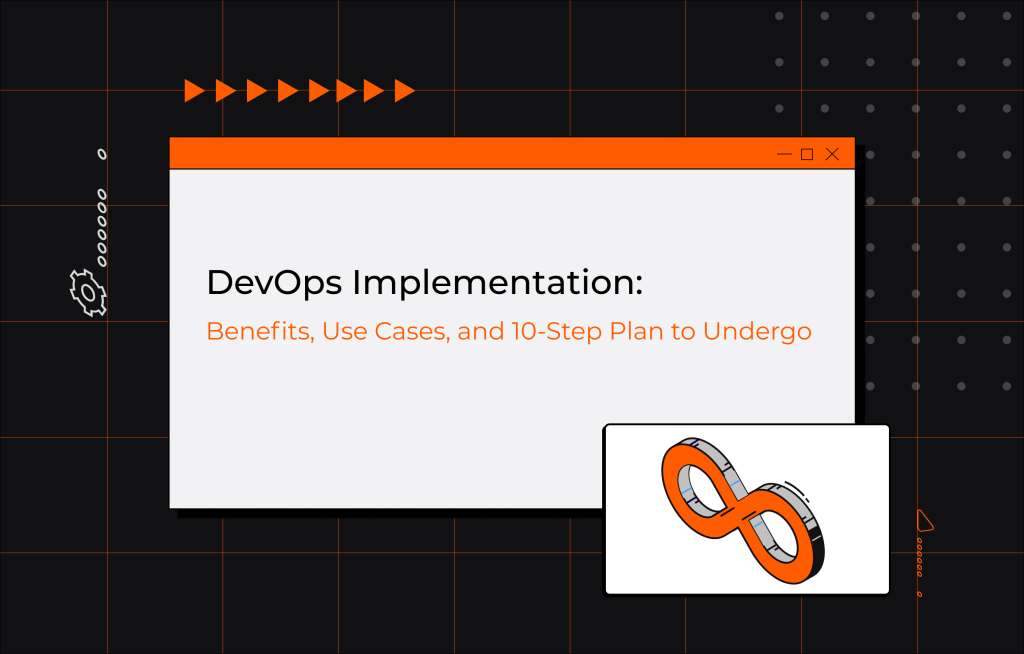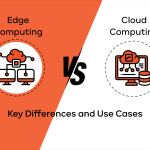DevOps is a method of software development that presupposes development (Dev) and operations (Ops) teams working together from scratch to testing.
In terms of methodology, DevOps implementation presupposes developing software in short cycles. Regarding infrastructure, DevOps provides your team with automation and communication tools.
The traditional development process is different. First, it takes the operation team to develop a plan, and only after developers come and do their job. That’s rigid, redundant, and brings about unnecessary halts.
DevOps is better. That’s why, today, over 60% of teams are at an advanced stage of their DevOps evolution, according to the DevOps evolution report.
In this article, you’ll discover:
Let’s get started.
Reasons for Implementing DevOps
Why implement DevOps?
Here’s an example: developers work on a product until the product is ready and inform operations: “Here’s the new version.” Then, operations run the new soft just to learn it has a bug and sends the whole batch to testing, who send it back to developers weeks later to fix bugs.
In the DevOps environment, all teams share common responsibilities from the start. For example, Ops are saying: “There’s a slider not working upon a release.” A Dev says: “I’ll take it” and fixes the code within minutes. Then, the marketing says: “Guys, the client has changed his mind on the banner, let’s swap it.” Again, the request gets addressed the very same day.
A, you see, DevOps implementation is about letting people from different teams communicate clearly and creating conditions for that. Logically, that sets a chain reaction of positive effects, like increased collaboration, better performance, and quality of client experience, cutting on IT expenses.
Increased collaboration
In the DevOps environment, effective collaboration is the main focus and asset. Accordingly, it receives a good portion of investment, like training the team on the collaborative culture, purchasing new tools, and constantly improving methodologies that ease message and report sharing.
In the DevOps ecosystem, a marketing person has access to the schedule of automatic code replications and can plan campaigns accordingly to set them alive without effort and lots of documentation for Devs.
Better Performance
Good performance is the ability to deliver good quality products at high speed. The DevOps approach lets you make frequent updates, quickly provide fixes, prevent disaster scenarios, etc. In addition, a lot of automation eliminates human errors resulting from the manual configuration of instruments.
Quality client experience
Implementing DevOps allows clients to take insights into any stage of product development, not to mention the faster response to client demands.
Before making a change request, a client had to inform the operations, which, in turn, had to prepare documentation for Devs. Finally, the latter had to reconfigure the environment to the change to be developed, tested, and released.
Now, teams can release code on demand. As a result, clients have more freedom in polishing their ideas without putting the teams in a request-permission ping-pong.
Cutting on IT-Expenses
Many automation tools eliminate time spent on development and testing and allow to spare resources on complex and innovative kinds of work that can bring more profit.
Factors to Consider for DevOps Implementation Strategy
In a query of how to implement DevOps effectively, you have to know what DevOps methodology is based on. DevOps implementation stages on six fundamentals, like improved integration, speed, quick delivery, reliability, scalability, and security.
Improved Integration
For implementing DevOps, you physically bring together the workflows and responsibilities of different teams. In other words, you create a collaborative environment and provide infrastructure for flawless communication. These steps allow teams to align on goals.
In practice, it looks like this: both teams have a shared project created with management software like Jira with tasks assigned, status tracked, blockers visible, and issues approached within minutes.
Speed
In terms of DevOps implementation, speed is moving along the tasks and overall project fast. It is about cutting the month-long gaps of production cycles to weeks and days.
Teams using agile methodologies have been used to speed. Since the DevOps framework is the evolution of agile, the demand to speed here is brought to a new level. In the DevOps environment, speed is enabled by continuous integration and development principles (CI/CD), of which we shall speak later.
Quick Delivery
When implementing DevOps, you get software developed in short cycles and supported by automation. Thus, your team can swap tasks so that they are not just performed fast but also frequent.
In practice, quick delivery translates into a fast recovery after a breach, real-time fixes of bad code, or code on-demand. Thanks to DevOps implementation, you don’t have to approach large chunks of code, but fix only the needed part with a surgeon’s precision and release it immediately.
Reliability
Continuous integration and delivery give what clients love most: they see what is going on with their project any minute. A client takes insight into interim results, and if something’s not fine, they can ask for a change. Moreover, this demand won’t cost them as much as it could with traditional development.
This way, implementing DevOps enhances reliability.
Scalability
The need to prepare code on-demand and stay cost-efficient goes hand-in-hand with scalability. That condition wouldn’t be easy to meet with rigid procedures of the traditional methodology.
DevOps implementation creates an environment where your team can get new infrastructure for development and testing in one click.
For example, a client needs an extra CPU for a high-peak period of Black Friday. A DevOps team will quickly rent extra capacity from the cloud server integrate it into their working environment without downtime, thanks to flexible working procedures. Then, after the sales, a team will stop the rent not to pay extra for the off-peak period.
Security
Security is an important point of a DevOps implementation roadmap.
A typical DevOps team also includes a security component. There is a special term for that: DevSecOps – a trinity of the development, security, and operations. In a DevSecOps team, security becomes a focus of everyone which enables a higher level of alertness to vulnerabilities.
Additionally, the DevOps method allows approaching and fixing security issues faster.
Before, in a hacker attack, the developers had to follow a traditional procedure of fix development, testing and update. It gave hackers time to take advantage of a vulnerability.
Now, a DevOps framework allows releasing fixes on-demand and bridge breaches in real-time.
Moreover, thanks to a great deal of automation, DevOps implementation allows avoiding human-related errors, which adds to the overall security of the development.
DevOps Transformational Roadmap
The obvious benefits of DevOps implementation are impossible without maintaining several principles that make DevOps architecture and philosophy different from traditional development.
In a DevOps environment, each service runs independently and communicates with other services through a special interface and integration tools.
This is achieved through uninterrupted processes of development, integration, testing, deployment, monitoring, and configuration management. Let’s review these instances closer.
Continuous Development
Continuos development is about deploying all code changes to a testing or production environment after developers are ready with the build stage. The aim of continuous development is to bridge the gap between build and deployment and optimize code building procedures.
Continuous Integration
Continuous integration is a practice where developers continuously merge the code changes they made into a shared central repository (like Git, for example). This is usually followed by automatic builds and tests.
Continuous Testing
Each time the application code is being updated in the repository by devs, it gets automatically tested by pre-scheduled automated testing tools. That eliminates the times needed for QA engineers to find bugs and fixes, and lets fix them in real-time.
Continuous Delivery
DevOps architecture allows developers to build code in small increments and deploy it each time when an update, even a minor one, is needed. With continuous delivery, code is always ready to be deployed.
Continuous Deployment (CD)
An important part of the DevOps implementation roadmap, continuous deployment is a practice of automated release of a new code into production. Numerous DevOps tools allow this process to be consistent through different environments.
Continuous Monitoring
Continuous monitoring presupposes ongoing monitoring of code and infrastructure by capturing and analyzing logs generated by applications. This gives visibility of what is going on in the DevOps environment and allows for quick fixes in case anything is not ok.
Configuration Management
During development, a piece of software goes through different environments. Each of the environments corresponds to a certain purpose, like integration or end-user testing.
For a flawless flow of a software development cycle, app environments should be configured and maintained properly. If that’s not done correctly, you may face system outages, leaks, and data breaches.
That is why configuration management is an important part of the DevOps implementation roadmap.
How To Implement DevOps
In this section, you’ll learn how to implement DevOps successfully. Our number one advice is to follow the best practices of DevOps implementation: evaluating your needs, building a team, focusing on end-users, creating a strategy, selecting tools, containerizing your application, automating testing and integration, proceeding in small steps, and monitoring your results.
1. Evaluate DevOps needs
DevOps implementation should be business-driven. In other words, you need to define what you want to improve and start in that direction. That may be long development cycles, security flaws, production defects, scaling, cloud migration communication issues, etc.
Keeping your business needs in focus is essential in the choice of tools and DevOps planning.
2. Build a Competent DevOps Team
Your job here flows in two principles: provide and train.
First, you should provide your team with a shared environment to apply DevOps principles. Yet, DevOps implementation isn’t just about merging the operations and development teams. This way, you only get a new department with an old vision.
You have to break walls between them. For example, DevOps roles and responsibilities get merged: marketing people get involved in the development process with customer feedback, the development team merges with quality assurance to bring quick fixes, etc.
Second, make sure your DevOps practitioners align with the method itself. They should be fast, flexible, collaborative. Train them on DevOps tools and procedures if needed. Make sure to train personnel into a collaborative culture too.
3. Put User Satisfaction to Center
Implementing DevOps has changed the whole culture of customer relations.
Remember the complex and time-consuming change request of the past? With the DevOps methodology, its short production cycles, and CI/CD principles, a customer can rightfully expect any request to be performed any time now.
The DevOps approach creates a basis for higher customer demands. This translates into the client’s presence in the development process, frequent deliverables, years-long support, and maintenance.
4. Create DevOps Implementation Strategy.
A plan should help you move on if you doubt a particular step. There are numerous ways you can cope with this task, but here’s a DevOps roadmap example for your inspiration:
Step 1. Create a shared working environment
Step 2. Think out DevOps roles and responsibilities carefully. Then, involve your team to see how ready they are to work with shared assignments.
Step 3. Set KPIs. There are metrics for measuring the DevOps team performance. Stick to these four to start: time to get code running in production, deployment frequency, time to recover, frequency of deployment failures.
Step 4. Ensure IT infrastructure provision on demand. Your team should be able to get new tools and hardware in a click.
5. Select the Right Tools
It’s hard to oversell the importance of the right tools for successful DevOps implementation. A couple of bad choices, and you find yourself between the so-called isolated islands of automation, where you have to do a lot of manual work to bridge instances.
It’s a good idea to try different options when starting.
Here’s a list of the most popular tools, grouped by different phases of the DevOps process:
a) Planning: Git, Jira
b) Coding: Slash, GitHub, GitLab
c) Version management: Docker, Puppet, Chef, Graddle
d) Testing: Selenium, Vagrant, JUnit, Codeception
e) Deployment: Kubernetes, Jenkins, OpeShift
f) Monitoring: Nagios, Splunk, Slack, Datalog
6. Containerizing
The next step in your DevOps implementation plan is containerizing. This approach allows you to deliver independent pieces of functionality in short cycles.
The container is an isolated environment with everything you need to develop, test, and deploy functionality: codes, libraries, dependencies, etc. This approach is also called microservice infrastructure.
7. Integrating Infrastructure Automation
Bringing in integration tools is also an essential part of DevOps implementation.
The essence is simple: you have tools for infrastructure automation like Kubernetes or Puppet and continuous development tools like Jenkins or Bamboo. Your task is to make them work together flawlessly.
8. Automating Testing
Automated testing makes things simpler and faster. For example, this lets you check your code immediately upon the development and correct it fast, not weeks after it was created.
9. The Idea to Start Small
While implementing DevOps, it’s better to start with small initiatives, like selecting the first app and scale as you feel confident with that. It’s popular, to begin with web-based agile applications.
10. Ensure Software Performance Monitoring
Many automation tools eliminate time spent on development and testing and allow to spare resources on complex and innovative kinds of work that can bring more profit.
How To Implement DevOps
You can monitor software performance by collecting data, such as the number of users, load time, version, or asking for direct feedback from users.
These data are essential for further DevOps implementation.
Summing Things Up
We hope you have an idea of how to implement Dev Ops successfully by this point. So let’s sum up what you’ve learned:
- DevOps implementation brings benefits like increased collaboration—better performance, quality client experience, and cunning off IT expenses.
- To implement DevOps successfully, you need to maintain six principles: improved integration, speed, quick delivery, reliability, scalability, security.
- DevOps implementation roadmap consists of seven practices: continuous development, integration, testing, delivery, deployment, continuous monitoring, and continuous management.
- If you develop a DevOps implementation plan, consider these steps: evaluate your needs, build a team, focus on a client, create a strategy, select tools, containerize application development, automate integration and testing, move in increments, monitor your results.
You may face issues developing the DevOps implementation roadmap, selecting proper tools, training a team, etc. In this case, it’s ok to find a skillful DevOps consultant for help.
IT-Magic is an excellent choice to help you with DevOps implementation. Our team can boast 10+ years of CI/CD experience and complex and personalized solutions for our partners.
Here’s how our clients have benefited after a successful DevOps implementation with IT-Magic:
- 26% improved collaboration
- 8x revenue growth
- 60% faster delivery
Interested in how our clients have achieved these results?
Contact IT-Magic for more information and learn how your business can benefit from our DevOps services.




